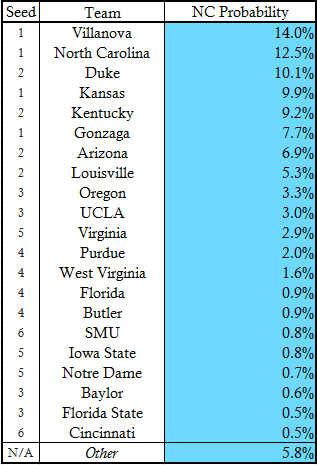
How to Win Your Bracket Pool
Before you begin reading this article, I want to make one thing abundantly clear: I’m not telling you how to fill out the perfect bracket; that’s impossible (insert cliche about the astronomically small odds of this ever happening). Rather, I’m giving you statistically sound, pragmatic advice on how to win your bracket pool between you and your friends (and the spoils that come along with it). If you follow these foolproof steps, you should finish at (or at the very least near) the top:
Step 1: Advance all 1 and 2 seeds to the Sweet 16.
Okay, I know, this is super chalky and people may rag on you for making this move. Furthermore, the odds are heavily against all eight 1 and 2 seeds advancing to the Sweet 16. However, picking which 1 or 2 seed is going to get upset is a fool’s gambit. You put yourself at risk of losing easy points that your opponents will gain. You’re better off taking a couple gambles in other early round games, and just playing it close to the vest here.
To further drive home my point, consider this – in the last eight tournaments, 48 of the 64 teams (75%) on the 1 and 2 seed line advanced to the Sweet 16. If you can essentially lock in 6 correct teams in your predicted Sweet 16, you should do it.
Step 2: Advance all 3 and 4 seeds to the second round.
The same chalkiness mentioned in step 1 definitely applies here as well, but the same logic applies as well. The difference here is that a lower seed upset over a 3 or 4 in the second round is much more likely in comparison to a similar 1 or 2 upset. Thus, auto-advancing the 3 and 4 seeds should only apply to the first round. It’s fun bragging about being the one person who accurately picked the crazy 14 over 3 upset, but you know what’s more fun? Bragging about winning your bracket pool.
In a similar fashion to step 1, I really want to drive home this point as well. In the last eight tournaments, 52 of the 64 teams (81%) on the 3 and 4 seed line advanced to the second round.
Step 3: Use the following statistical data to pick the 7/10 and 8/9 games.
In years past, I focused my statistical analysis of college basketball on simply trying to build a predictive model to attempt to reveal who was going to win the entire NCAA tournament. This year, I wanted to go more in-depth and try to find predictive variables and isolate patterns based on recent historic results in order to attempt to predict these first round coin flip games. Doing this will allow the individual team match-ups to come into play, rather than simply projecting which teams have the best chance to advance the furthest, regardless of opponent.
I used historic tournament results from 7/10 and 8/9 games that took play between 2010 to 2016. These games were batched together in order to increase the predictive power of the model. Upon completion of my model, the following variables demonstrated predictive power in these match-ups:
- Strength of Schedule
- Pace
- Offensive Efficiency
- Defensive Efficiency
- Efficiency Margin
- Turnover %
- Wins
- Offensive Rebound %
- Effective 3-Point Rate
After inputting the 2016-2017 statistics for all of the 7 through 10 seeds in this year’s tournament, my model yielded the following results:

Step 4: Use the following statistical data to pick the 5/12 and 6/11 games.
In a similar vein to the 7/10 and 8/9 games, I wanted to use historic tournament results to attempt to find the most likely upset specials in the 5/12 and 6/11 games. Predicting these games will use the same variables listed above, but with different multiplicative factors attached to each variable. The predictive accuracy in 5/12 and 6/11 games is more volatile than their coin-flip counterparts, but that is to be expected, as the games themselves tend to be more volatile.
After inputting the 2016-2017 statistics for all of the 5, 6, 11, and 12 seeds in this year’s tournament, my model yielded the following results:

Step 5: Your final four should consist of some combination of the following teams.
As I mentioned above, I previously developed a predictive model to attempt to project who has the best chance of advancing far into the tournament, regardless of match-up. I refined the past model to further optimize the predictive results, then normalized the projections for each region to create a probability of reaching the final four for every team in the tournament. Below are charts that feature every eligible team (all non-double digit seeds not excluded by the steps above) separated by region:
(I recommend selecting a team with at least a 10% chance of advancing to the Final Four)

Step 6: Your national champion should be one of the following teams.
The same predictive model from step 5 applies here in step 6. The analysis of all the factors that are most predictive when projecting a national champion is the area where I have committed the most time and performed the most research. This is not coincidence, as this is the most valuable prediction when it comes to winning your bracket pool. Below is a chart that features every eligible team (not excluded by the steps above) in the tournament that has at least a 0.5% chance of winning the tournament:
